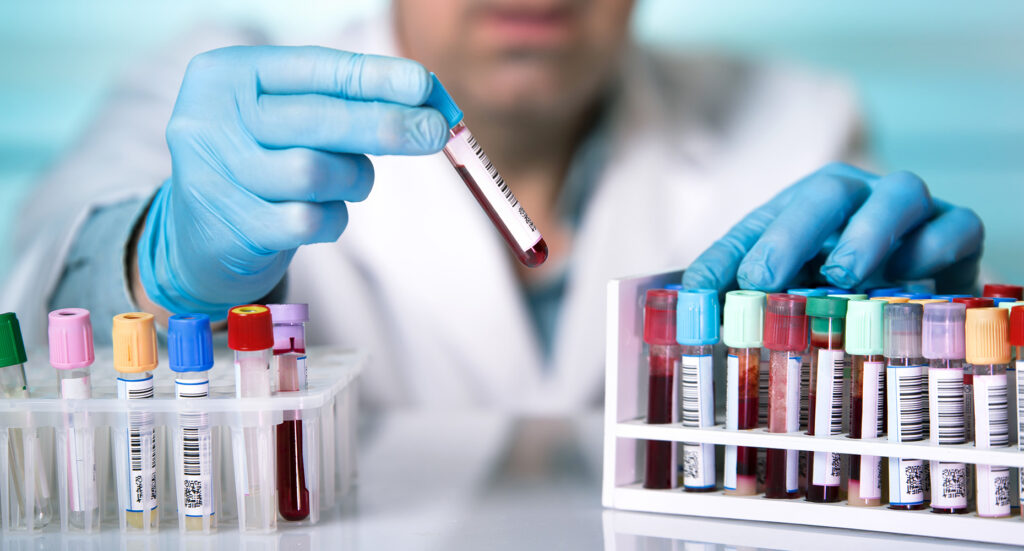Point-of-Care Testing in Primary Care: The Future Is Now
For many patients, a trip to the laboratory is shrouded in mystery. Once a blood sample is collected and whisked away, the waiting begins. Sometimes results take hours. Other times, it’s days. In general, patients are unaware of the factors that dictate timing of results and of the repercussions that can be related to long waits. They just want to know what, if anything, is wrong!


Point-of-Care Testing in Primary Care:
The Future Is Now
September 14, 2021
.
For many patients, a trip to the laboratory is shrouded in mystery. Once a blood sample is collected and whisked away, the waiting begins. Sometimes results take hours. Other times, it’s days. In general, patients are unaware of the factors that dictate timing of results and of the repercussions that can be related to long waits. They just want to know what, if anything, is wrong!
But the times, they are a-changin’ – increasingly, patients are being deluged with information about health, medicine and even testing. Certainly, COVID-19 has raised awareness of testing, with scores of patients flocking to testing centers. And a YouTube search for “hemoglobin A1C” will yield an array of clinicians and other “authorities” offering opinions on that assay. Media offer advice on tests that patients should be requesting. Meanwhile, patients visiting grocery or drugstores can select from a number of over-the-counter test kits or pop into an in-store clinic for routine testing.
In this evolving environment, is physician office testing falling behind?

Testing Tradition
Many clinicians are familiar with the shortfalls of the traditional testing model.1 In this scenario, the patient visits the office, the physician orders a test, the patient travels off-site to provide a sample and results are communicated electronically or directly in a matter of hours to days. Any needed follow-up has to be arranged and usually takes place in the form of a phone call, email or second visit to the office.
This system is riddled with cracks through which a patient often falls. First and foremost, the need for a trip to an off-site laboratory provides ample opportunity for the patient to skip the test. Travel requirements and time constraints can easily become obstacles. This is especially true in the case of patients in underserved communities.2, 3
Once a patient does receive a result, there are still scenarios that can derail the process. Patients may not fully understand the need for a follow-up appointment or may simply fail to follow through. As a result, extra staff time must be spent in pursuit of the patient. The end result is that a second appointment may be delayed or may never occur. Delayed or missed treatment can be serious in the case of a new diagnosis as well as in cases of chronic illnesses.1, 4
Closing the Gaps
Numerous studies have reported that the implementation of point-of-care tests (POCT) can play a role in improving patient satisfaction and care.1 The availability of test results during an office visit allows physicians to address medication or treatment, counsel patients or order further testing during a single visit. POCT not only ensures adherence, but also drives efficiency within the practice.
Conversations regarding testing results can take place immediately. The enhanced patient engagement provides an opportunity to build rapport, educate the patient and establish trust, which can be key to care on a long-term basis. POCT can also reduce the time that staff use to contact and schedule additional visits. And having fewer follow-up visits opens the door for other types of visits, which could be higher revenue producers.



Evaluating the Economics
On the topic of finances, some have questioned whether POCT comes at a greater cost than most practices care to bear. A 2021 review of publications evaluating the health economic effects of POCT sought to examine cost as a factor influencing uptake of in-office testing.1 Authors reviewed 44 publications examining POCT in a variety of U.S. and international healthcare settings (70% primary care). The publications evaluated a broad spectrum of POCT tests aimed at preventing unneeded treatment.
More than 75% of evaluations recommended implementation of POCT (although in certain cases, only under specific circumstances and conditions.) According to the review, the perceived economic value of POCT varied according to use:
- Screening: This application was not widely studied in the reviewed publications. While not all publications calculated cost/benefit ratio, the majority concluded that POCT is a cost-effective option.
- Diagnosis: Nearly 60% of publications evaluating POCT for diagnosis concluded in favor of POCT implementation.
- Monitoring: This application was evaluated by less than a third of the publications reviewed. Only one deemed POCT to be more expensive and less effective.
According to the authors, the evaluations most frequently cited several key health economic benefits of POCT:
- Early diagnosis
- A decrease in the number of hospitalizations and referrals to specialized care
- Reduced risks of infection and antibiotic prescription
- A decrease in additional burden and costs associated with referrals and additional testing
In some cases, cost benefits even continued to improve over time.
In summarizing their findings, the authors said, “From this review, it is apparent that many publications find POCT to be a valuable counterpart to traditional laboratory testing or usual care. However, POCT should not always be perceived as cost saving. Some publications indicated that implementing POCT would result in higher costs, but this was justified by the long-term gains, such as increased life expectancy, reduced unnecessary referrals to specialists, unnecessary antibiotic prescriptions and decreased length of stay.”



POCT Hesitancy
Certainly, the evidence supporting POCT appears to be strong. Why, then, has the uptake among physician practices been slow? Some possible reasons:
- Cost-effectiveness of POCT can vary according to the target disease. Studies suggest that disease categories that may benefit from POCT are diabetes, infectious disease, and hemoglobin testing.1, 5
- The implementation process may be disruptive.
- In regard to labor costs, practices will need to determine whether certain functions (QA, specimen collection, IT) can be handled by existing staff.
- Practices may be concerned about workflow issues, but this concern may be addressed, in part, by POCT that can automate workflows or link to automated systems.
Absent an extensive survey or study examining attitudes toward POCT, it is difficult to determine the exact barriers to bringing more testing into the practice. But one thing is clear: Other clinical entities are investing heavily in bringing testing into nontraditional locations. And once patients establish the routine of obtaining tests and vaccinations at these sites, will more care be diverted in that direction? The implications of such a shift in care are yet to be determined.
Interested in advancing healthcare and patient satisfaction in your practice? HemoCue is ready to help you explore how POCT implementation can be done efficiently and cost-effectively.
Footnotes:
1 Lingerfelder, Deon, et al. “Health Economic Evidence of Point-of-Care Testing: A Systemic Review.” PharmacoEconomics, vol. 5, pp. 157-173, 6 Jan. 2021, https://doi.org/10.1007/s41669-020-00248-1.
2 “Access to Health Services.” Healthypeople.gov, 2020, https://www.healthypeople.gov/2020/topics-objectives/topic/Access-to-Health-Services.
3 Diamant, Allison L, et al. “Delays and Unmet Need for Health Care Among Adult Primary Care Patients in a Restructured Urban Public Health System.” Am J Public Health, vol. 94, no. 5, 2004 May, pp. 783–789, doi: 10.2105/ajph.94.5.783.
4 Al Hayek, Ayman A, et al. “Assessment of Patient Satisfaction with On-Site Point-of-Care Hemoglobin A1c Testing: An Observational Study.” Diabetes Ther. 20 Jul. 2021, https://doi.org/10.1007/s13300-021-01126-7.
5 Hardy, Victoria, et al. “Which Point-of-Care Tests Would Be Most Beneficial to Add to Clinical Practice? Findings From a Survey of 3 Family Medicine Clinics in the United States.” Point of Care, vol. 16, 2017, pp. 168–172.
Related Articles
Introducing the HemoCue Customer Portal
